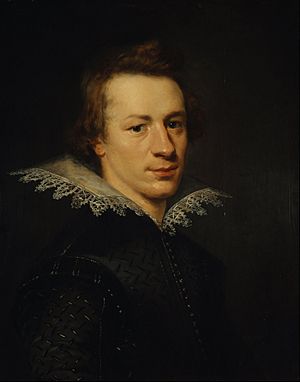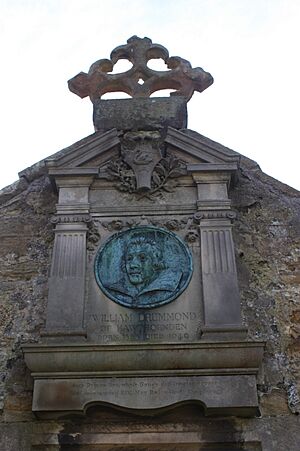William Drummond of Hawthornden facts for kids
Quick facts for kids
|
|
|---|---|

William Drummond of Hawthornden by Abraham Blyenberch, oil on canvas 1612, Scottish National Portrait Gallery, Edinburgh
|
|
| Born | 13 December 1585 Hawthornden Castle, Midlothian, Scotland |
| Died | 4 December 1649 (aged 63) Hawthornden Castle, Midlothian, Scotland |
| Nationality | Scottish |
| Alma mater | University of Edinburgh |
| Genre | Poetry |
William Drummond (born December 13, 1585, died December 4, 1649) was a famous Scottish poet. He was often called "Drummond of Hawthornden" because of his home. He wrote many poems and essays, and was known for his beautiful writing style.
Contents
Early Life and Education
William Drummond was born at Hawthornden Castle in Midlothian, Scotland. His father, John Drummond, was the first owner (laird) of the castle. His mother, Susannah Fowler, was the sister of another poet, William Fowler.
William went to the Royal High School of Edinburgh. He then studied at the University of Edinburgh, graduating in 1605. After that, he spent two years in France, studying law in Bourges and Paris.
In 1609, he returned to Scotland. When his father passed away in 1610, William became the laird of Hawthornden at just 24 years old.
Becoming a Writer
Even though he studied law, Drummond loved reading and writing. He had a huge collection of books, including many first editions of famous works from his time. When he became his own master, he decided to focus on poetry and history instead of law.
In 1612, he started writing letters to Sir William Alexander, who was also a poet. They became lifelong friends.
First Published Works
Drummond's first published work came out in 1613. It was a poem called Teares on the Death of Meliades. This poem was written to honor Henry, Prince of Wales, who had died.
In 1616, he published a collection of his own poems. It was titled Poems: Amorous, Funerall, Divine, Pastorall. These poems showed that he had studied the works of other famous poets like Philip Sidney and Italian writers.
Meeting Ben Jonson
In the winter of 1618–1619, Drummond had a very famous visitor: the well-known English playwright Ben Jonson. Jonson stayed at Hawthornden Castle for about two weeks.
Drummond kept notes about their conversations. These notes give us a peek into Jonson's thoughts on himself and other writers. Jonson even told Drummond that his poems were "too much of the schooles" and not quite "after the fancie of the time." These private notes were later published, which caused some debate about Jonson's opinions.
Later Life and Inventions
From 1625 to 1630, Drummond likely traveled a lot in Europe. He also showed an interest in inventions. In 1626, he received patents for 16 different devices, mostly for military use.
These included a special type of "Glasses of Archimedes" that could supposedly set ships on fire from a distance. He also designed an early form of a machine gun. This machine would have many musket barrels fastened together, allowing one person to do the work of many soldiers. However, there is no proof that he actually built any of these inventions.
In 1632, Drummond married Elizabeth Logan. They had five sons and four daughters together.
Political Views
Drummond was a very loyal supporter of King Charles I. He preferred the Episcopalian way of worship over Presbyterianism. He believed in strong authority and disliked democracy.
When King Charles I visited Scotland in 1633, Drummond helped organize the King's parade through Edinburgh. He also wrote speeches and poems to celebrate the visit.
Drummond often wrote pamphlets to share his political ideas. For example, he wrote a letter in 1635 arguing against the unfair trial of Lord Balmerino. He also wrote a history book called History of Scotland during the Reigns of the Five Jameses, which was published after his death.
During the difficult political times in Scotland, Drummond reluctantly signed the Covenant in 1639 to protect himself. However, he continued to support the King. He wrote pamphlets defending the King's supporters, known as Cavaliers, against the Rump Parliament.

Death and Legacy
William Drummond passed away on December 4, 1649. It is said that the news of King Charles I's execution deeply affected his health.
He was buried in a stone vault at his local church in Lasswade. His tomb was repaired in 1892, and a bronze plaque was added above the entrance.
Public Memorials
William Drummond is one of the 16 poets and writers whose faces are carved into the Scott Monument in Edinburgh. You can find his image on the north side of the monument.
Important Works
Drummond's most important works are his collection of poems and an essay called The Cypresse Grove.
The Cypresse Grove is a deep essay about why people should not fear death. In it, he writes about how small our Earth is compared to the vast universe. He often used phrases like "the All" in his writings, showing his philosophical thoughts.
Drummond's poetry was influenced by English and Italian poets, especially Edmund Spenser and Giambattista Marino. He was sometimes called "the Scottish Petrarch" because his love sonnets were very expressive and stood out among other poems of his time.
A funny, mock-heroic poem called Polemo Middinia is also believed to be written by him. It's a story about a country fight, written in a mix of Latin and Scottish Gaelic words.
The composer Gerald Finzi even set three of Drummond's poems to music in his work Three Short Elegies (1926).
Archives and Collections
William Drummond was a keen collector of books and manuscripts. He donated over 600 items to the University of Edinburgh, where he had studied.
His donations included valuable books on literature, history, and science. He also gave several early printed copies of Shakespeare's plays, including a copy of Romeo and Juliet published during Shakespeare's lifetime.
A special book of memories kept by William Drummond and later by his son is now held at the University of Dundee.
See also
 In Spanish: William Drummond para niños
In Spanish: William Drummond para niños
- Henry Adamson



